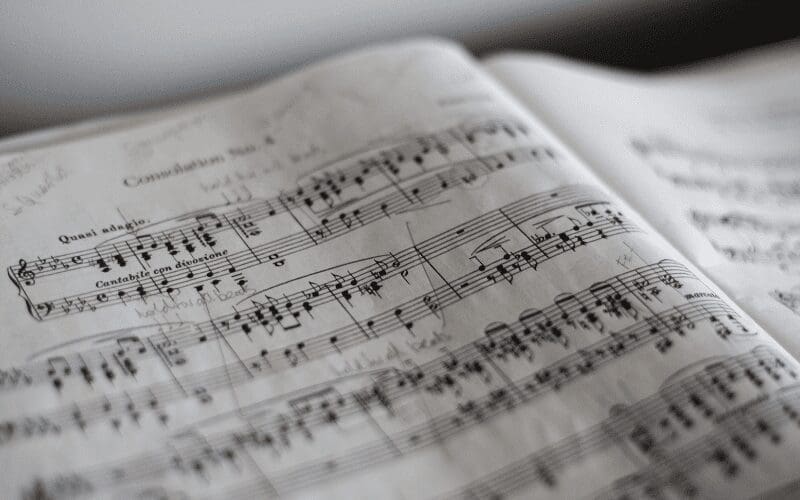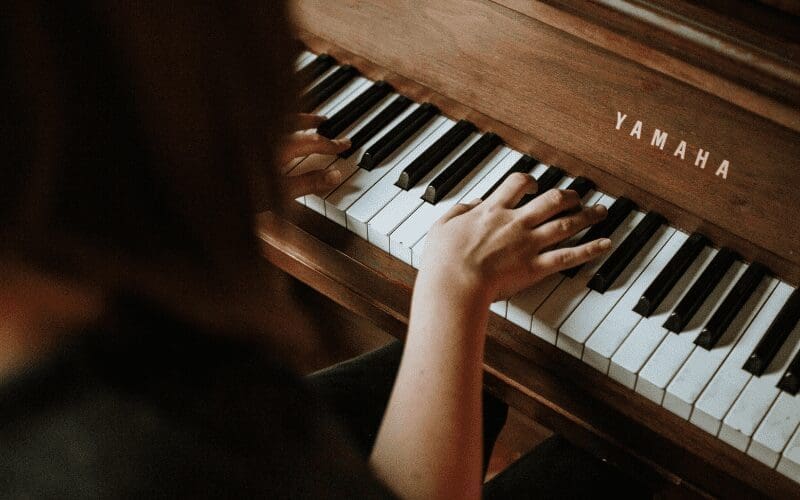Ever listened to a song and had it stuck in your head for days? This is because of the song‘s melody. It is usually the most memorable and recognisable part of a song, as the melody is the part of the song that is easy to pick up and remember.

Writing a good one is often tricky, and a great melody will vary from one person to the next. For example, songs like Aerosmith’s’ I Don’t Want To Miss A Thing or My Heart Will Go on by Celine Dion are examples of great melodies.
They have continually made the lists for greatest melodies, however, not everyone may like these number-one hits. In this article, we will look at what a melody is and how it came to be.
Melody Definition
So what is melody? The dictionary defines a melody as ‘a musical sequence of single musical tones that are organized in a song or a musical number’. This is one of the basic elements for all musicians and songwriters.
A note is a single sound with a certain pitch and rhythm, but when a number of differently pitched musical notes have been put into a sequence, a melody is formed.
However, it is important to note that not all musical successions are classed as one. It should be sonically pleasing and is the part of the song that lingers in your memory. Most melodies are usually quite simple and often repeated throughout songs.
A melody is crucial to many modern pop songs today. It is usually the the chorus or a few verses that follow that have the same note pattern, and are carried out throughout the song. There are two key elements of a melody.
Firstly, there is pitch, which is the audio vibrations we hear when an instrument is played. Then, there is duration, which describes the length of the sounds we hear from instruments.
The History Of Melodies
Antonio Vivaldi – Storm
Music has been around for at least the last 43,000 years. One of the oldest songs that have survived in its entirety in the world is a Greek song that was written during the AD 100s. The song known as “Seikilos Epitaph” was found inscribed on a marble tombstone in Turkey and came with musical notations.
Melodies have advanced over many centuries, with periods such as the Medieval and Renaissance eras refining music. However, many musicologists suggest that the European Baroque era (between the 17th and 18th century) is when music made its biggest advancements in history. Notable Baroque musicians include:
- Antonio Vivaldi
- Georg Philipp Telemann
- Henry Purcell
- Alessandro Scarlatti
Johann Sebastian Bach – The Best Of Bach
Johann Sebastian Bach was one of the most influential composers of the European Baroque era, and essentially shaped the principles of what we know melodies to be today.
His advancements in both harmonies and melodies transformed music, and inspired most of the music that was written in Western music following him.
His tradition of a stepwise motion in music has lasted for centuries, and can be heard in most musical numbers from opera music composed by Giuseppe Verdi to Saxophone solos from jazz artists such as John Coltrane.
Not only has Bachs’ stepwise notion (where notes move only by a half-tone or whole-tone) survived the test of time, but other elements of his compositions are still heard in modern music. For example, occasional leaps and focal points.
These additional elements were used to make certain parts of the melody stand out, and distinguish a section of the composition from another part. Focal points on sheet music often look like a V or W pattern.
Melodies & Sheet Music

On sheet music, both pitch and duration are denoted on a 5-line staff. The shape of notes and where they lie on these lines represent the pitch and duration.
The length of melodies can be long or short. Short melodic line sequences are also known as a riff or motif.
Use Of Melodies In Music

The human ear hears higher-pitched noises a lot easier than lower-pitched ones. Because of this, the melody of most songs is usually of a higher pitch compared to other components of a song. It needs to stand out and grasp the attention of the listener.
A melody is used by nearly all musicians, no matter what genre they perform or what instrument is used.
Solo singers also use melodies when singing the main part of a song, i.e. the chorus. Choruses also sing melodies, however, some melodies vary in pitch rather than the same notes being sung in unison.
Members of a typical church choir sing consistent melodies at different ranges, but they all follow the same rhythm. Percussion instruments also play melodies, but often when played by an instrument, the focus is more on the duration instead of pitch.
There are many classical music numbers filled with pitched percussion instruments i.e. music from Gustav Mahler or Pierre Boulez.
Melodies In Music
Composers of Western classical music often introduce an initial melody and then add in variations.
Most Western classical music compositions have numerous melodic layers, called polyphony. Often, melodies are created from motifs or short melodic fragments.
The opening of Beethoven’s Fifth Symphony is a good example of this.
Ludwig Van Beethoven’s 5th Symphony in C Minor
Although many jazz numbers are actually improvised and don’t follow set musical phrases, in Jazz, instrumentalists use the term “lead” or “head” to refer to the central melody which is used as a starting point.
Rock music and other popular music genres tend to follow only one or two melodies throughout the chorus and verses. Sometimes a third distinct melody, called a bridge, is added to songs as a break.
Melody Vs Harmony
So, what is the difference between melody and harmony? A melody is often referred to as a hook, however, it should not be confused with harmony.
Although the two go hand in hand with each other, a melody is simply a collection of notes. Harmony happens when a layer of notes comes together. There are usually two or more different sounds coming together to form a harmony.
Think about playing a song on the piano where one hand is playing one melody, and the other hand is playing a different one. Both melodies come together to form a harmony.
How To Create A Melody

You can start off composing a melody by choosing at least two major chords, such as C or F.
Use an instrument or the piano function on your DAW to play the initial chords and loop it, or record over Midi for payback via the DAW software.
Either play an instrument or sing with a tune in mind. Get creative as possible until you find a tune that works best.
Ensure your recording device is set up and ready to capture the process, and to ensure you remember your new masterpiece!
Our Conclusion
Writing great a great melody is not a talent that can be formed overnight. It is something you will need to practice and improve over a long period. Never give up!
If you have been trying and trying to come up with a good tune with little to no luck, always remember that there are many successful artists who were once in the same position.
Broaden your music horizons. You never know where you might find inspiration. Listen to a wide variety of songs from different genres and eras and try to focus on the distinct melodies that intertwine to create full songs.
Approaching writing a tune with an experimental, improvised nature gives you the best chance at developing one that is unique. Most music listeners favor originality as well as something sonically pleasing! To hear more about the use of melody in music and songwriting, check out our article.
So, now that you have all the help you need to get writing melodies and songs, we want to help boost your career and get those songs noticed, including promoting your music and improving your streaming presence!
Also, check out our Sync opportunities page to get your music in TV and Film. Try it out for free today by signing up.










